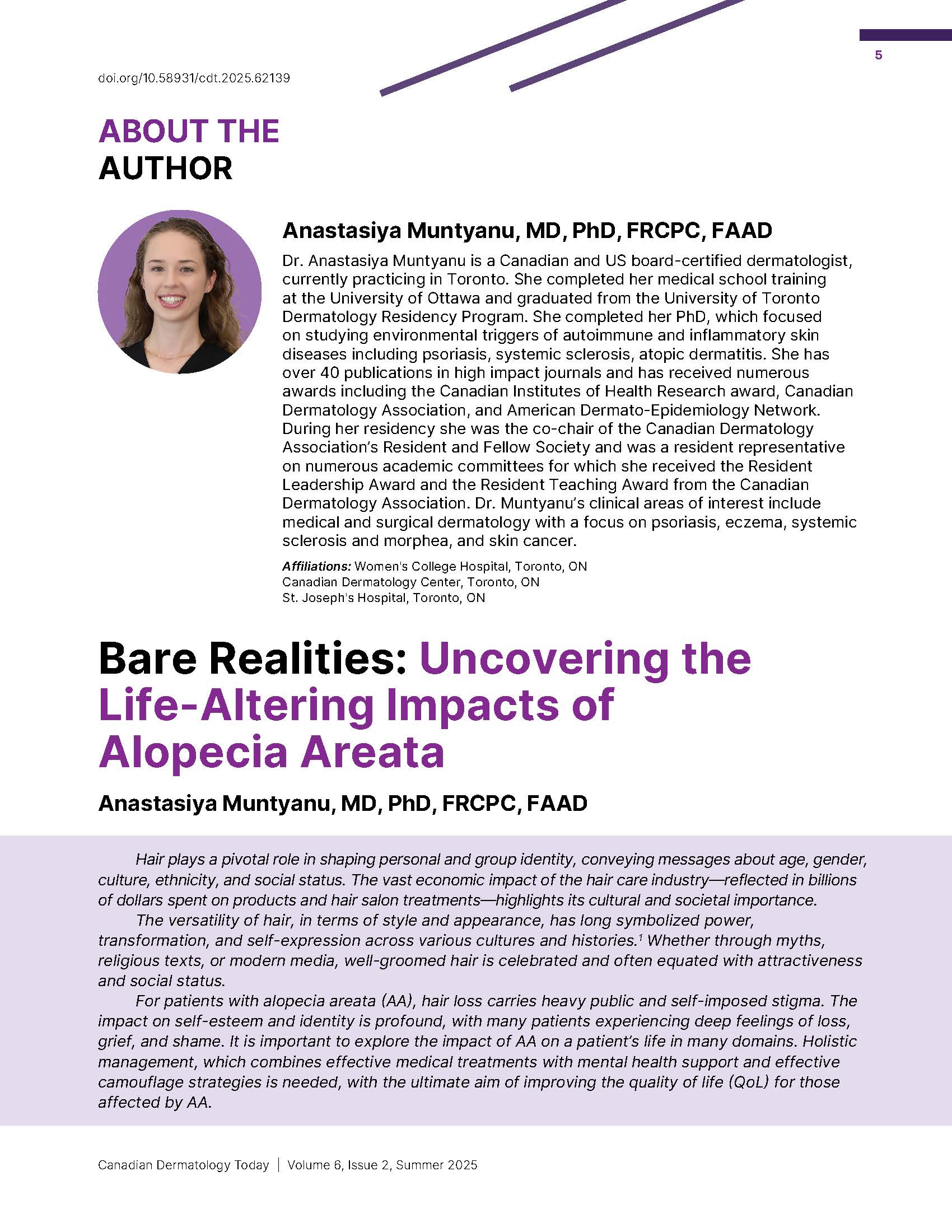Bare Realities: Uncovering the Life‑Altering Impacts of Alopecia Areata
DOI:
https://doi.org/10.58931/cdt.2025.62139Abstract
Hair plays a pivotal role in shaping personal and group identity, conveying messages about age, gender, culture, ethnicity, and social status. The vast economic impact of the hair care industry—reflected in billions of dollars spent on products and hair salon treatments—highlights its cultural and societal importance.
The versatility of hair, in terms of style and appearance, has long symbolized power, transformation, and self-expression across various cultures and histories. Whether through myths, religious texts, or modern media, well‑groomed hair is celebrated and often equated with attractiveness and social status.
For patients with alopecia areata (AA), hair loss carries heavy public and self-imposed stigma. The impact on self-esteem and identity is profound, with many patients experiencing deep feelings of loss, grief, and shame. It is important to explore the impact of AA on a patient’s life in many domains. Holistic management, which combines effective medical treatments with mental health support and effective camouflage strategies is needed, with the ultimate aim of improving the quality of life (QoL) for those affected by AA.
References
Wan SJ, Donovan J. Hair loss and identity-from Homer to Donne. J Cutan Med Surg. 2018;22(6):656. doi:10.1177/1203475418786211
Villasante Fricke AC, Miteva M. Epidemiology and burden of alopecia areata: a systematic review. Clin Cosmet Investig Dermatol. 2015;8:397-403. doi:10.2147/CCID.S53985
Finner AM. Alopecia areata: Clinical presentation, diagnosis, and unusual cases. Dermatol Ther. 2011;24(3):348-354. doi:10.1111/j.1529-8019.2011.01413.x
Alkhalifah A, Alsantali A, Wang E, McElwee KJ, Shapiro J. Alopecia areata update: part I. Clinical picture, histopathology, and pathogenesis. J Am Acad Dermatol. 2010;62(2):177-188, quiz 189-190. doi:10.1016/j.jaad.2009.10.032
King BA, Senna MM, Ohyama M, Tosti A, Sinclair RD, Ball S, et al. Defining severity in alopecia areata: current perspectives and a multidimensional framework. Dermatol Ther (Heidelb). 2022;12(4):825-834. doi:10.1007/s13555-022-00711-3
Liu LY, King BA, Craiglow BG. Alopecia areata is associated with impaired health-related quality of life: a survey of affected adults and children and their families. J Am Acad Dermatol. 2018;79(3):556-558 e551. doi:10.1016/j.jaad.2018.01.048
Muntyanu A, Gabrielli S, Donovan J, Gooderham M, Guenther L, Hanna S, et al. The burden of alopecia areata: a scoping review focusing on quality of life, mental health and work productivity. J Eur Acad Dermatol Venereol. 2023. doi:10.1111/jdv.18926
Matzer F, Egger JW, Kopera D. Psychosocial stress and coping in alopecia areata: a questionnaire survey and qualitative study among 45 patients. Acta Derm Venereol. 2011;91(3):318-327. doi:10.2340/00015555-1031
Mesinkovska N, King B, Mirmirani P, Ko J, Cassella J. Burden of illness in alopecia areata: a cross-sectional online survey study. J Investig Dermatol Symp Proc. 2020;20(1):S62-S68. doi:10.1016/j.jisp.2020.05.007
Tzur Bitan D, Berzin D, Kridin K, Sela Y, Cohen A. Alopecia areata as a proximal risk factor for the development of comorbid depression: a population-based study. Acta Derm Venereol. 2022;102:adv00669. doi:10.2340/actadv.v102.1622
People who develop alopecia areata have an increased risk for depression, anxiety, time off work and unemployment. British Journal of Dermatology. 2022;187(1):e49-e49. doi:10.1111/bjd.21283
Wang LH, Ma SH, Tai YH, Dai YX, Chang YT, Chen TJ, et al. Increased risk of suicide attempt in patients with alopecia areata: a nationwide population-based cohort study. Dermatology. 2023;239(5):712-719. doi:10.1159/000530076
Montgomery K, White C, Thompson A. A mixed methods survey of social anxiety, anxiety, depression and wig use in alopecia. BMJ Open. 2017;7(4):e015468. doi:10.1136/bmjopen-2016-015468
Rajoo Y, Wong J, Cooper G, Raj IS, Castle DJ, Chong AH, et al. The relationship between physical activity levels and symptoms of depression, anxiety and stress in individuals with alopecia Areata. BMC Psychol. 2019;7(1):48. doi:10.1186/s40359-019-0324-x
Li CY, Tai YH, Dai YX, Chang YT, Bai YM, Tsai SJ, et al. Association of alopecia areata and the risk of dementia: a nationwide cohort study. J Clin Psychiatry. 2021;82(6).21m13931 doi:10.4088/JCP.21m13931
Macbeth AE, Holmes S, Harries M, Chiu WS, Tziotzios C, de Lusignan S, et al. The associated burden of mental health conditions in alopecia areata: a population-based study in UK primary care. Br J Dermatol. 2022;187(1):73-81. doi:10.1111/bjd.21055
Christensen T, Yang JS, Castelo-Soccio L. Bullying and quality of life in pediatric alopecia areata. Skin Appendage Disord. 2017;3(3):115-118. doi:10.1159/000466704
Senna M, Ko J, Tosti A, Edson-Heredia E, Fenske DC, Ellinwood AK, et al. Alopecia areata treatment patterns, healthcare resource utilization, and comorbidities in the US population using insurance claims. Adv Ther. 2021;38(9):4646-4658. doi:10.1007/s12325-021-01845-0
Li SJ, Mostaghimi A, Tkachenko E, Huang KP. Association of out-of-pocket health care costs and financial burden for patients with alopecia areata. JAMA Dermatol. 2019;155(4):493-494. doi:10.1001/jamadermatol.2018.5218


